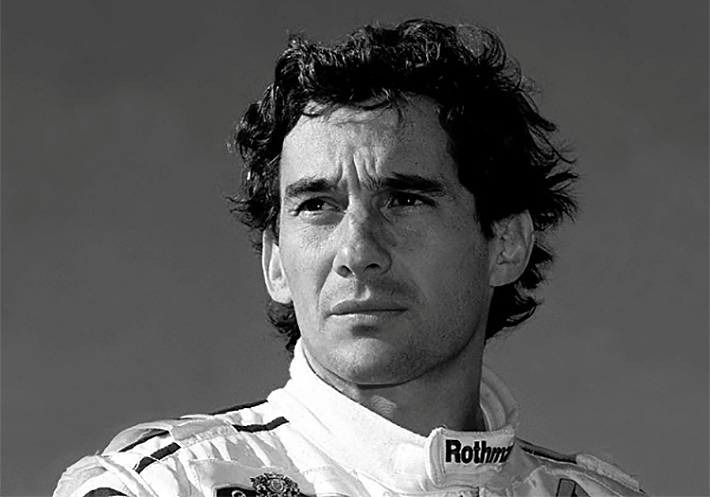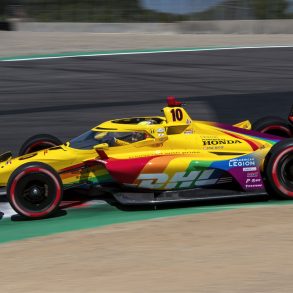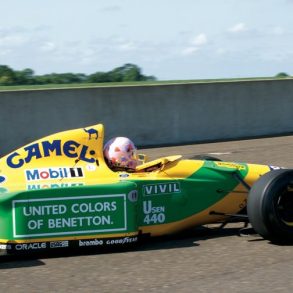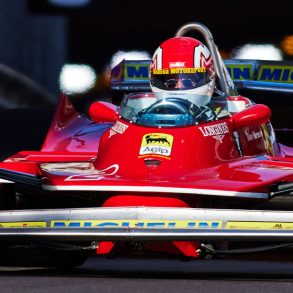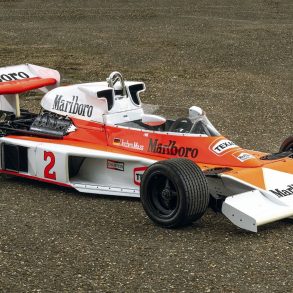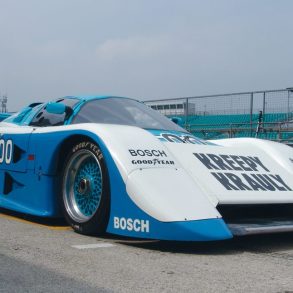Ayrton Senna Biography
Ayrton Senna was born on 21 March 1960, the second child of Milton da Silva, a successful businessman and landowner. The family lived in Santana, a well-to-do neighborhood of Sao Paulo, Brazil. Growing up Ayrton was an awkward child and was later diagnosed as having a motor coordination problem. His doting father, who was a motor racing enthusiast, noticed how his serious little son was also attracted to cars. The senior d Silva had amongst his many holdings a car components company and believed that cars would be the key to reach his son’s potential. At the age of four Ayrton was presented with a 1-hp kart and getting behind the steering wheel he was a different boy, no longer awkward but focused and confident. The key had been found and every weekend the family would go to local parks where Ayrton could drive his kart. He was an indifferent student but facing the loss of his “driving” privileges he would apply himself as best he could while his heart was obviously elsewhere.

He was finally thirteen and could race legally. His first race was that same year and held at the karting track, which was part of the Interlagos complex. Arrayed against him were all of the local hot shots including Mauizio Sala. Ayrton displaying all of the pent up energy he had built up to this seminal moment won the race. The adult Senna would later relate that karting was the perfect breeding ground for future racecar drivers. In 1977 Ayrton won the South American Kart Championship and repeated the following year. The goal for any aspiring karting driver was Europe and the World Championships at Le Mans. Against much stronger competition Ayrton managed to finish sixth overall which was considered sensational for a driver with his experience, but he came away disappointed in not winning any of the three races which constituted the final. In 1979 he returned to Europe for further seasoning and finishes second in the World Championships at Estoril. Nivelles in Belgium the following year saw another second.

Fans of car racing, especially the elite Formula One format, will get a rush from the excellent documentary Senna, a profile of the rock star-handsome Brazilian driver Ayrton Senna. But Senna is a film that all audiences can enjoy–because of its big heart and its engaging portrayal of its star. And the riveting footage of Senna’s Formula One races, and his knife-edge daring behind the wheel, don’t hurt either. Ayrton Senna grew up in Brazil, where he began his love affair with driving as a competitive go-kart racer at the age of 13. Senna follows young Ayrton’s journey into full-fledged racing, and allows Senna’s gentle personality to shine through as he begins to make his name in racing circles. The viewer learns that Senna loved the Catholic Church almost as much as he loved racing, and his humility and his ongoing love for his fellow Brazilians, especially those in poverty, would be themes that lasted throughout his life. Senna would go on to become one of Formula One’s best and most accomplished competitors ever–and his steely nerves and willingness to take risks on the track paid off in Grand Prix after Grand Prix. Senna, deftly directed by Asif Kapadia (Far North, The Warrior), lets the singular personality and charisma of Senna–and the spectacular theatrics of F-1 racing–tell his story without any forced drama or fanfare.
Though Senna’s racing career would be far too short, his legacy lives on, and Senna is a gripping reminder of how blazing a talent can be–even behind the wheel of a car. –A.T. Hurley
The next stop would be Formula Three, which was the last step before Formula 1. The British Formula Three Championship was made up of 20 odd races and proved the perfect test of man and machine. Two drivers entered 1983 as pre-season favorites, Ayrton Senna, as he was now known and the great British hope Martin Brundle. Senna promptly ran up nine straight victories before crashing out in practice for the next race which was won by Brundle. The series now became a contest between the two pre-season favorites with neither driver backing down. The Championship would be decided in the final race at Thruxton. Senna, showing the determination and attention to details that would be his hallmark, had his engine re-built and tuned by the master tuners Novamotor of Italy. Senna took pole and won the race and the title going away. The end of the year for Formula Three was celebrated in the Portuguese enclave of Macau at the Macau Grand Prix with drivers from all of the national series. Senna won and negotiations between him and a number of Formula One teams became serious. This also became a time where Senna was introduced to the politics of the senior Formula. After wanting to go to Brabham but being vetoed by Piquet, Toleman became his only option. Strictly a second-tier team, Toleman was able to sign the most promising driver in a generation to a three-year contract.
Senna made his Formula One debut in front of his home country in 1984 driving for the Toleman team but things were different then Formula Three. Here even the best driver without the right car and engine would not be able to make much of an impression on the leader board. The team would eventually form the basis for the Benneton team but at that time was strictly a back marker and the best that he could do was qualify eighth. The next race at San Marino was a new experience for Ayrton; he failed to qualify. After the initial series of races in his inaugural season the results were slow in coming. For the French Grand Prix he was given a new car but the results were the same when he suffered turbo problems and had to retire.
The next race was at Monaco and Senna qualified well back in thirteenth place. The weather was run under threat of rain and Senna began to feel that he might have his first real opportunity. Wet weather, as it always was in racing is the great leveler and by the seventh lap Senna was in sixth place. On lap eleven he almost crashed when he jumped a curb and the Toleman became airborne. Prost who was in the lead came upon Teo Fabi who had spun and stalled in the middle of the track. Just narrowly missing Fabi’s car he struck one of the track marshals. Not knowing weather he had killed the poor man, he hadn’t, Prost was shaken by the incident.
Mansell, a much harder fellow saw the opening and assumed the lead. Once ahead he began to stretch his lead quickly, a little to quickly and spun into the Armco barrier. Lauda who was in second place made a small error and also spun out. On lap 20 Prost led the oncoming Senna by 33.8 seconds. On lap 31 the gap was reduced to 7.4 seconds. The weather conditions continued to be treacherous and every time that Prost crossed the finish line he would signal for the race to stop. On lap 31 the race was stopped and Senna was denied his first victory but the legend was born.
Monaco would prove the highlight of the season but for Senna it wasn’t enough. It was plain to him that he would need a stronger supporting cast if he wanted to challenge for the Championship.
Senna had been secretly negotiating with Lotus for the following season and even though he had a three-year contract with Toleman he did have a buy-out clause. Lotus represented to the young Senna the pinnacle, the team of Clark and Fittipaldi, but Lotus had been on the downward slope after the death of their founder Colin Chapman. To his new team Senna was the man to return them to the top. After showing the racing world a glimpse of the future at Monaco, Senna was more determined than ever to break through. Driving in treacherously wet conditions he would win his first race at Estoril. This was followed by another win at Spa, Belgium. But even Senna could not return Lotus to their prior glory and in 1988 he moved to McLaren. Ironically instead of vetoing Senna as his teammate, Prost initially welcomed the Brazilian. At last all of the pieces were in place and that year saw him win 8 races and his first World Championship. In 1989 he came in second to his teammate Alain Prost despite having more wins. The relationship between the two had deteriorated to the point where Prost left McLaren to join Ferrari. In 1990 and 1991 Senna, now joined at McLaren by Gerhard Berger, won back to back titles while being involved in fierce battles with Prost and Nigel Mansell. Eventually the loss of Honda power and the rise of Renault would bring about the decline of McLaren.
Great rivalries are among the glories of sport, and Malcolm Folley’s book Senna Versus Prost … examines one of the most fascinating Guardian The writing is excellent, which is no surprise coming from this seasoned journalist. The narrative is intelligent … A familiar story is still worth telling if done well. In this case, it’s mission accomplished. Motor Sport thanks to Folley, we have Alain Prost’s account of a time when F1 ran red from the pit stop to the podium to enlighten us on one of racing’s greatest rivalries GQ … for a superb insight into antagonism between F1 team-mates, read Malcolm Folley’s brilliant new book Senna Versus Prost, which charts the rivalry between two of the sport’s greatest-ever drivers Daily Mirror With the inside track of having covered the sport for a number of years, Folley writes with authority as he weaves a picture of the sporting greats lives and rivalry Press Association Having covered the sport for a number of years, Folley writes with authority as he weaves a picture of the lives of two of the sport’s greats and how their rivalry played out Daily Star Malcolm Folley’s excellent book gives a blow-by-blow account of a fascinating chapter in F1 history. 4 stars, Irish Daily Star on Sunday magazine a breathtaking read Brighton Argus

This final tragedy will haunt Formula 1 for many years. Ayrton Senna brought with him seemingly limitless talent and indomitable will to win. On the track he could be almost belligerent yet off the track he was just beginning to show a more generous and thoughtful demeanor to the outside world that those who knew him best had always known was there. Those brief shining years when Ayrton Senna, Mansell, Prost and Nelson Piquet would fight tooth and nail for the slightest advantage both on and off the track seem like so long ago.
“Monte Carlo, ’88, the last qualifying session. I was already on pole and I was going faster and faster. One lap after the other, quicker, and quicker, and quicker. I was at one stage just on pole, then by half a second, and then one second…and I kept going. Suddenly, I was nearly two seconds faster than anybody else, including my teammate with the same car. And I suddenly realized that I was no longer driving the car consciously.”
“I was kind of driving it by instinct, only I was in a different dimension. It was like I was in a tunnel, not only the tunnel under the hotel, but the whole circuit for me was a tunnel. I was just going, going – more, and more, and more, and more. I was way over the limit, but still able to find even more. Then, suddenly, something just kicked me. I kind of woke up and I realized that I was in a different atmosphere than you normally are. Immediately my reaction was to back off, slow down. I drove slowly to the pits and I didn’t want to go out any more that day.”
“It frightened me because I realized I was well beyond my conscious understanding. It happens rarely, but I keep these experiences very much alive in me because it is something that is important for self-preservation.”
Ayrton Senna

EFDA Formula Ford 2000 Championship, Jyllandsring, Denmark, 22 August 1982.




Monaco Grand Prix, 11/05/1986, Monte Carlo.





